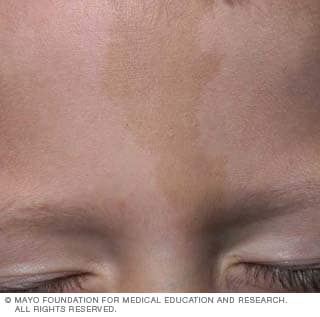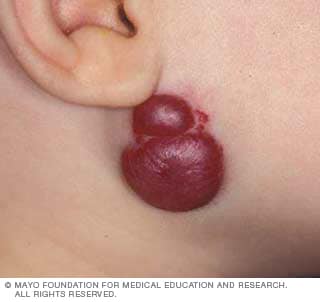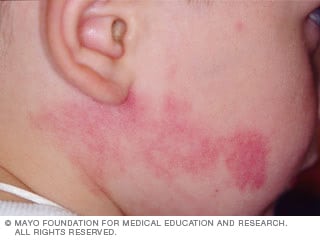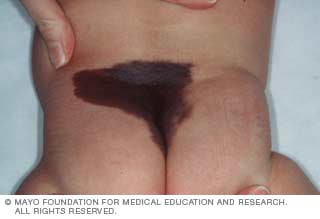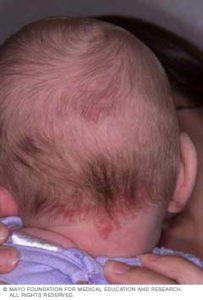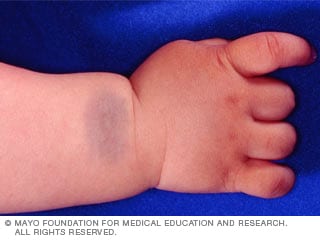Quick Links
- Moles
- Cysts
- Skin Tags
- Seborrheic Keratoses
- Birthmarks
- Frequently Asked Questions About Benign Skin Growths
- Treatment of Moles
- Treatment of Cysts
- Frequently Asked Questions About Cysts
- Treatment of Skin Tags
- Frequently Asked Questions on Skin Tags
- Café Au Lait Spot
- Hemangioma
- Port-Wine Stain
- Congenital Nevus
- Salmon Patches/Stork Bites
- Slate Gray Nevus
- Treatment of Birthmarks
- Frequently Asked Questions on Birthmarks
Small pieces of skin that protrude from the surface are known as skin tags. They are sometimes mistaken for growths that look like warts but they are not infectious or contagious. Birthmarks appear as the name suggests, at birth or soon afterward. They are usually harmless but can be cosmetically undesirable or lead to an underlying problem if they grow rapidly.
When people encounter moles, cysts, skin tags, and birthmarks, they may be worried about cancer growth or something more severe than a primary skin lesion. The fact is that these conditions rarely progress beyond benign skin lesions. However, if you notice any changes occurring in or around your skin blemish, it would be wise to consult a skin expert.
It is important to pay close attention to any moles and growths you notice and consult with the skin experts at Trillium Creek Dermatology to determine if treatment is required.
Moles
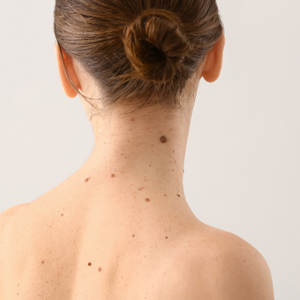
Beneath the top layer of your skin are specialized cells called melanocytes. These produce a pigment called melanin in response to exposure to ultraviolet light and are the reason that your skin tans in the sun. Melanin is important because it serves to protect your skin from sun damage. People with naturally dark skin produce more melanin than people with fair skin.
It is not unusual for melanocytes to grow and develop in small groups or clusters. When they do, they appear as a darkened spot or mole, also known as a nevus. Moles are very common and almost always non-cancerous. They can be flat (known as a junctional nevus) or raised (compound nevus) and are usually smaller than a pencil eraser with clearly defined edges. Colors range from pink to brown or black and the overall shape is round or oval.
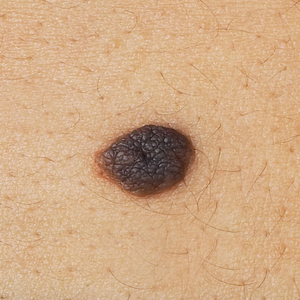
Moles are clearly most noticeable on the skin’s surface of the face or scalp but can be present anywhere on your skin. Moles that are uniform in color are usually nothing to worry about. They may be present on your baby’s skin at birth and new moles will probably appear throughout their childhood. Again, these are unlikely to be problematic. Existing moles on women may darken during pregnancy as a response to hormonal changes. This is perfectly normal and harmless.
Aside from pregnancy, a change in the color of your mole is something to be checked. If your mole changes in color or shape, or shows signs of damage such as crusting, weeping, or even bleeding, then you should ask a skin specialist to take a look at it. Moles that are itchy, moles that don’t look like the others on your skin, or new moles that suddenly appear in adulthood, should all be investigated.
Moles that change in this manner can be cancerous and may be melanoma. Not all melanomas will arise from moles, but many do begin at or near the site of a mole or other dark spot on the skin.
One in fifty people will be diagnosed with melanoma at some point in their life. The actual level of risk varies based on ethnicity. Fair-skinned people are 25 times more likely to develop melanoma than dark-complected people.
The cancer survival rate is excellent when melanoma is detected and treated early. If not caught at an early stage, melanoma can spread aggressively to other parts of the body.
Frequently Asked Questions About Benign Skin Growths
Can dry skin cause bumps?
Can I remove seborrheic keratosis myself?
Can keratosis become cancerous?
Can you pick off seborrheic keratosis?
Can you prevent keratosis?
Can you scratch off actinic keratosis?
How can you tell the difference between melanoma and seborrheic keratosis?
How do you get rid of benign skin growth?
How do you get rid of keratosis?
Is there a cream for seborrheic keratosis?
Is there an over the counter treatment for seborrheic keratosis?
Should I remove seborrheic keratosis?
What are bumps on skin called?
What are the different types of skin growths?
What causes benign skin growths?
What causes skin growths?
What do cancerous skin growths look like?
What does actinic keratosis look like?
What is the difference between actinic keratosis and seborrheic keratosis?
What triggers seborrheic keratosis?
Treatment of Moles
Because most moles are completely harmless, they do not require treatment, but some moles get irritated and are removed. After mole removal, they will generally not reappear. Your Trillium Creek Dermatology medical professional can get rid of the entire mole quickly with minimal pain and no downtime. We are serving the following communities and those surrounding: Wooster, Wadsworth, Medina, Brunswick, Strongsville, and Hinkley.
We recommend a yearly full body exam by a Trillium Creek Dermatology skin expert who is trained to detect areas of concern on your skin. In addition, if you find a suspicious area on your skin where a mole has changed, contact us right away – we do have same-day appointments.
If a cancerous melanoma is suspected, a tissue biopsy is performed for an accurate diagnosis. Skin cancers are referred to our Mohs Skin Cancer Center at Trillium Creek Dermatology for removal.
Cysts
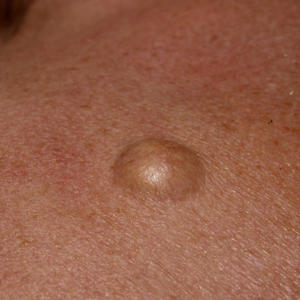
Sac-like growths that appear as domed bumps or nodules are generally known as cysts. They can be found throughout the body in joints and some internal organs. Cysts on the skin are referred to as epidermoid cysts. They can be present in babies and children but tend to appear over time in adulthood.
An epidermoid cyst develops as the result of disruption to the skin around the hair follicle where the skin cells form a discrete sac, coupled with the build-up of a light brown protein known as keratin within the sac. Keratin is a natural protein that is the main structural constituent of hair. Cysts can also contain fluid or hair.
Although we still have much to learn about them, a number of factors are known to promote the formation of cysts. The most common is an association with acne vulgaris. Acne also affects the follicles of the skin and causes local skin damage. This promotes the formation of a closed sac in which a cyst can build.
Smoking is also believed by some to be a causative link, although the exact mechanism for this is unclear. Some people who develop cysts in middle age may in fact be suffering from pilar cysts (a specific type of cyst on the scalp). These have a genetic link where a dominant gene is passed down through the generations. Pilar cysts affect women more than men.
Cysts occur mostly on the face, eyelids, neck, ears, and body. Although they pose no immediate threat and may even reduce over time, some people choose to have them surgically removed for cosmetic reasons. Occasionally a cyst can become infected and cause sensitivity and pain as it places pressure on the surrounding skin and nerve endings.
Treatment of Cysts
Small cysts below the skin are, in general, completely harmless and do not require treatment. If a cyst becomes infected, your Trillium Creek Dermatology skin expert may prescribe oral antibiotics to fight the infection and may drain the contents of the cyst to relieve pressure and discomfort. However, the cyst may recur because the sac wall has not been removed.
Cysts can be surgically removed, and by removing the sac or cyst wall, they generally do not reappear.
Frequently Asked Questions About Cysts
Are bakers cysts painful?
Are cysts hereditary?
Are skin cysts dangerous?
Can a cyst be hard like bone?
Can a cyst be mistaken for a tumor?
Can a dermatologist remove a cyst?
Can a sebaceous cyst go away on its own?
Can a skin cyst turn into cancer?
Can an ultrasound tell the difference between a cyst and a tumor?
Can you pop a cyst?
Can you drain a cyst at home?
Can melanoma look like a cyst?
Do cysts grow bigger?
Do cysts move under the skin?
Do you need stitches after cyst removal?
Does Cyst Removal leave scar?
How big can a cyst get?
How can you tell a cyst from a tumor?
How do I get rid of cyst?
Is cyst a cancer?
Is cyst removal painful?
What can happen if a cyst is left untreated?
What cancers cause cysts?
What causes cysts on your privates?
What does a cyst feel like?
What does a sebaceous cyst look like?
What happens if you pop a cyst?
What is cyst removal called?
What is inside a cyst?
What is the fastest way to get rid of a cyst?
What kind of doctor can remove a cyst?
When should I be concerned about a cyst?
Our medical professionals at Trillium Creek Dermatology can remove cysts quickly with minimal pain and no downtime.
Skin Tags
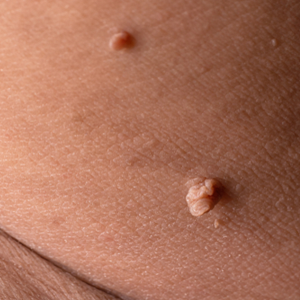
Skin tags are very common and generally occur after midlife. As skin tags are usually harmless, people tend to have them removed for aesthetic or cosmetic reasons. Sometimes skin tags will be removed because of irritation where they catch on clothing or jewelry. Skin tags may also be removed because they interfere with routine skin care routines like shaving.
The characteristic skin tag is a small protruding bag of skin which is generally no more than 1/6th of an inch across, although larger skin tags are possible. The skin tag is attached to the surrounding skin by a narrow neck or stalk known as a peduncle.
Skin tags are usually found on the neck, chest, back, armpits, under the breasts, or in the groin area. They are sometimes known as “cutaneous soft fibromas”.
It is not entirely certain what causes skin tags, but it is believed that areas, where the skin is rubbed, are more prone to skin tags. Certain individuals are also associated with an an increased risk or likelihood of skin tags. These include:
- People who are overweight or obese – where skin tags are most likely to form between skin folds and creases,
- Pregnant women – most likely due to the natural hormonal changes of pregnancy,
- Individuals with diabetes – the exact mechanism is not known, but is thought to be due to the body’s resistance to insulin,
- Illegal steroid use – steroids interfere with the body and muscles, causing the collagen fibers in the skin to bond, allowing skin tags to be formed,
- People with the human papilloma virus (low-risk HPV 6 and 11) – the relationship between virus and skin tags is not fully known.
Treatment of Skin Tags
Skin tag removal is a quick and straightforward procedure. There are a number of published ‘home remedies’ for ridding yourself of skin tags, but many of these treatments are ineffective or can lead to complications such as infection. Others are dangerous and extreme and can even make your skin look worse!
For peace of mind, we always recommend seeking professional help to make sure that your skin tags are professionally removed using sterile instruments in a safe environment.
Our skin experts at Trillium Creek Dermatology can advise you about your skin tags and remove them for you.
Frequently Asked Questions on Skin Tags
How does Tea Tree Oil remove skin tags?
How long do skin tags last?
How long does it take for Compound W to remove a skin tag?
How long until skin tags fall off after freezing?
Should I be worried about skin tags?
What acid is used to remove skin tags?
What are skin tags caused by?
What causes skin tags around eyes?
What does a skin tag look like?
What does it mean when a skin tag hurts?
What is the difference between a mole and a skin tag?
When should I worry about a skin tag?
Why am I suddenly getting lots of skin tags?
Seborrheic Keratoses
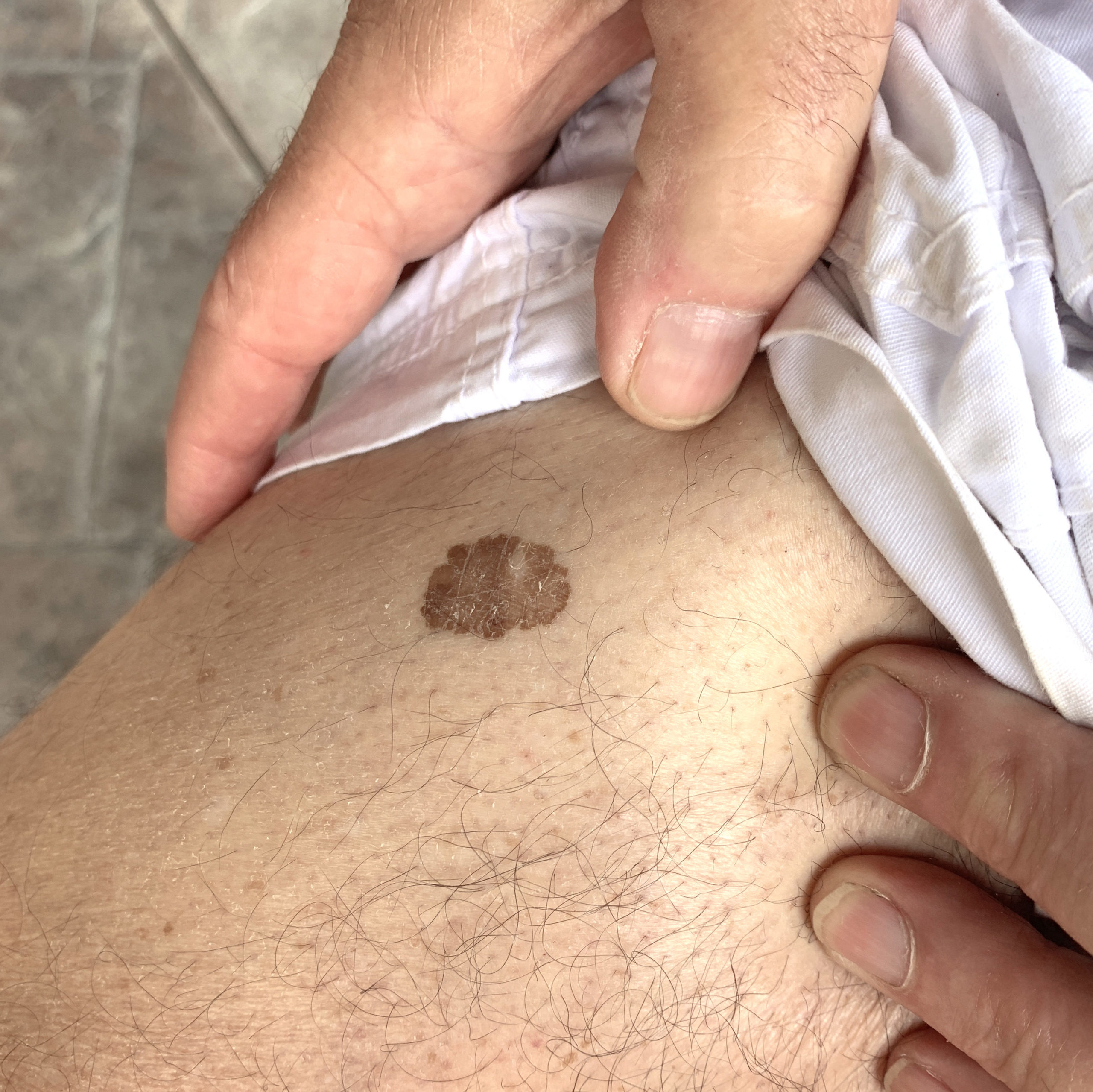
Seborrheic keratoses are very common benign skin growths that sometimes can be mistaken for moles. Some people may refer to these lesions as “wisdom spots,” “barnacles,” or “age spots.” Seborrheic keratoses are harmless and are usually found in middle-aged adults and older individuals. These lesions often appear in multiples and can occur on the face, scalp, abdomen, back and legs. They are typically brown in color, but can be many different shades of tan, black, light brown or even flesh colored. In rare cases, an abrupt onset of many seborrheic keratoses can be a cause for concern, but the lesions themselves are completely benign. Most people develop seborrheic keratoses within their lifetime. Genetics and long-term sun exposure play a large role in the development of these lesions.
Typically, seborrheic keratoses do not cause symptoms. However, some people may report itching, irritation, rubbing against clothing and occasionally bleeding. If these symptoms occur, removal may be warranted in these instances.
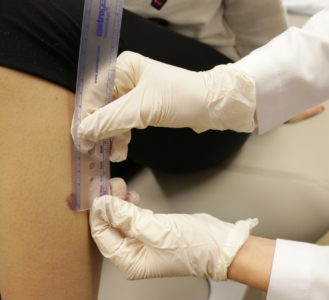
The best way to diagnose a seborrheic keratosis is by an examination by your dermatology provider. Most of the time, these lesions can be clinically diagnosed in the dermatologist’s office. In rare cases, a skin biopsy may be warranted if there is any question for concern.
Since seborrheic keratoses are harmless growths, these lesions can be left alone without treatment. If there is a desire for removal for cosmetic or symptomatic reasons, this can be accomplished by the following methods:
- Electrodessication/Curettage: Involves numbing the skin and using a surgical tool called a curette to scrape away the lesion.
- Cryotherapy: Involves a cold spray of liquid nitrogen to freeze the growth where it will then fall off after 1-2 weeks.
- Acids: Superficial lesions can successfully be removed in the office with an acid based topical. More than one treatment may be needed for complete removal.
- Chemical peels
- Alpha hydroxy acids: Has been shown to result in a smoother appearance. Examples include glycolic and lactic acid topical lotions. These products can be found on our H&H Science website or boutiques located all four Trillium Creek locations.
Birthmarks
Birthmarks aren’t always present at birth. Some, such as hemangiomas, will develop several weeks later. Most are permanent, but a few types fade as a child grows and the birthmark becomes less noticeable.
There are two main processes that are responsible for birthmarks. The first occurs when blood vessels under the skin are found to be slightly malformed. These birthmarks are often red, purple, or pink in color. Birthmarks that carry more of a brown tint are due to clusters of pigment cells within the deeper layers of the skin. The process here is similar to that responsible for the formation of moles.
Birthmarks are common and usually harmless. Treatment is often carried out purely for cosmetic reasons. However, in some cases intervention is recommended if a birthmark is seen to be growing rapidly or changing in nature, or where there are indications of underlying disease.
Treatment of Birthmarks
Birthmarks usually require no intervention as they are harmless. The removal of some birthmarks requires simple surgery, but laser therapy is most effective in reducing the pigmentation of most birthmarks and provides good cosmetic results without a scar.
Your skin experts at Trillium Creek Dermatology can advise you of the treatment options available for your birthmark and can treat you promptly with minimal disruption.


